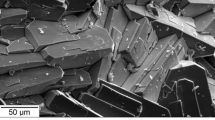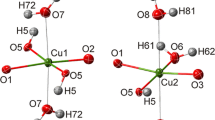Abstract
The chemical bonding in the ring silicate mineral dioptase is investigated on the basis of accurate single-crystal X-ray diffraction data. A multipole model is used in the refinements. Static deformation electron density is mapped for the silicon tetrahedron, Cu-octahedron and water molecule in different sections. The silicon tetrahedron exhibits peaks resulting from σ-bonds between Si–sp3 hybrid orbitals and O–p orbitals. The excess density is located on bonds between the Si atom and bridge (in ring) O(1)-, O(1′)-oxygens and across the interior of the Si–O–Si angle. In the Jahn-Teller distorted Cu octahedron, in addition to peaks which result from single Cu–O σ-bonds, there are peaks which are due to 3d electrons. The analysis of crystal-field influence on the Cu charge distribution is made using the tetragonal D 4 d approximation for the low-symmetry (C1) Cu octahedron. The calculation of the occupancies of the 3d atomic orbitals shows that the Cu non-bonding orbitals are most populated (˜20%) and the bonding orbitals least populated (14%), as is typical for the Jahn-Teller octahedron. The effective atomic charge on the Cu atom in dioptase determined from the multipoles is +1.23e: closer to the Cu+1 than to the Cu+2 state. The charge on the Si atom has a value +1.17e, which is in the range typical for Si atoms already determined by this method. The accumulation of density on bridge oxygens and across the interior of the Si–O–Si angle may be explained by additional strain in the bond with the decrease of the Si–O–Si angle in dioptase to 132°. The same effect was found earlier in coesite.
A single-crystal neutron diffraction study shows that dioptase becomes antiferromagnetic below a Néel temperature of 15.9(1) K, in contrast to the previously reported specific heat anomaly at 21 K. The magnetic propagation vector is (0, 0, 3/2) on the hexagonal triple cell or (1/2, 1/2, 1/2) in rhombohedral indices. The relation between the antiferromagnetic and the charge-density models for dioptase is discussed. The less occupied Cu d x2−y2 orbitals are responsible for the magnetic properties. These lie in the Cu–O squares, which are approximately perpendicular to c hex, but which are alternately inclined to it by a small angle. The magnetic moments of 0.59(1)μ B on the Cu ions in the same level are ordered ferromagnetically, but between ions in alternate levels the coupling is antiferromagnet. Within experimental error the magnetic moments are perpendicular to the square planes, which make an angle ±13(3)° to the triad axis.
Similar content being viewed by others
Author information
Authors and Affiliations
Additional information
Received: 8 June 2001 / Accepted: 10 January 2002
Rights and permissions
About this article
Cite this article
Belokoneva, E., Gubina, Y., Forsyth, J. et al. The charge-density distribution, its multipole refinement and the antiferromagnetic structure of dioptase, Cu6[Si6O18]·6H2O. Phys Chem Min 29, 430–438 (2002). https://doi.org/10.1007/s00269-002-0246-6
Issue Date:
DOI: https://doi.org/10.1007/s00269-002-0246-6




